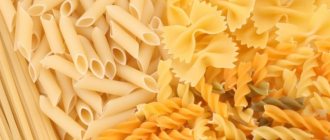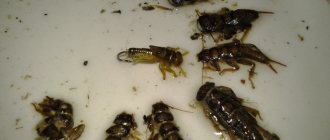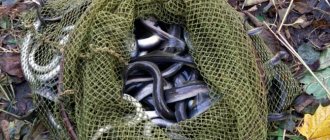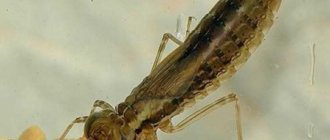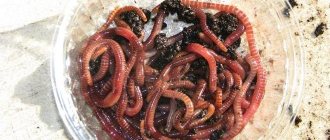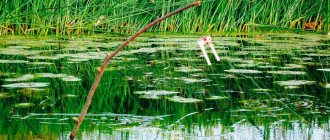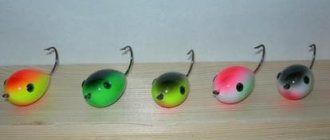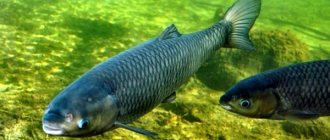Description
A characteristic representative of the superorder Angioptera is the caddisfly. Adults resemble moths with a dull color. They are small in size. The front part of the wings is covered with hairs. The insect's name, Trichoptera, comes from the Greek words for “wing” and “hair.”
The caddisfly and its larvae develop best in close proximity to water. Habitat: surrounding water bodies. Serves as food for underwater inhabitants and a key link in the food chain. It is found in rivers, reservoirs, streams and lakes.
The life cycle of an insect consists of egg, larva, pupa and butterfly. It remains in the second stage for most of life. The time interval between pupation of the egg and turning into an insect is 2 years. Interesting as fish food at every stage. It is more difficult to find a pupa, as well as to place it on a hook, so fishermen deal with larvae. This applies to caddisflies that create a house around themselves, since there are individuals that live without it.
By the way, not only caddis flies are used for fishing - the dragonfly larva also serves as bait, as does the fully formed insect, but there are some nuances. For example, fish living in the upper layers of water bodies bite on an adult dragonfly, while all others are successfully caught on a larva.
Fishing with caddis larva
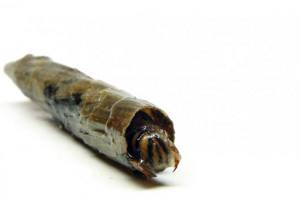
It should be remembered that fish react extremely actively to caddis flies only in spring, namely from the beginning of May until the first weeks of June. They fish for caddisfly in winter, but it is extremely difficult to catch it.
The most preferred tackle for catching caddis flies is a float rod. Before baiting the hook (with any gear), you need to remove the larva from its house. By the way, the fish especially prefer dark green caddis flies.
Having chosen a feeder or a traditional donka, you can safely cast the bait in creeks or lulls formed not far from the main current. Fishing on the rifts and backwaters will also be successful.
If the bank is steep and the current is strong, you can use fishing line. Bait actively moving in the water layer is unlikely to leave a good chub or bream indifferent.
Reproduction
The female caddisfly lays eggs directly in plants. The deep parts of the reservoir are preferable, since there is less danger there. There are also varieties that reproduce on land. The caviar has a slimy consistency, and the testicles are located inside. This is a favorable environment for the development of larvae. As it grows, the shell is eroded or removed from the caddisfly. The shape of eggs and their clusters depends on the species. In most cases, it is an oblong or spherical lump of mucus. You come across cords that look like bagels or round plates. The eggs are arranged in a spiral pattern.
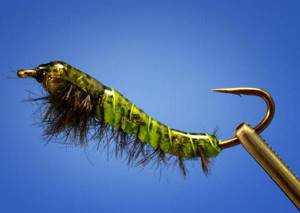
Development
The caddisfly larva molts and grows, simultaneously completing its tube-shaped home, making it more spacious. After covering the dwelling, the insect carries it along with it, moving along the bottom. The chest, head and 2-3 legs are exposed. In case of danger, the larva hides in a case, like a turtle. The head closes the entrance. Ascent for breathing is not required: oxygen comes from the water through the abdominal covering and nourishes the blood. The larvae have tracheal gills and bushy outgrowths on the abdomen. As a weighting agent, the insect attaches pebbles or shells of small mollusks (empty or with an inhabitant) to the house.
The insect undergoes a complete transformation. Pupae and larvae are found at the bottom or in the water, near the shore. As a result, the larva is reborn into an insect with a round head and a downward mouth. The eyes are faceted, located on both sides. Above and in front there are no more than 3 dark eyes, distinguished by a rather complex structure. The direction of the optical lenses is in different directions. There is an eye on the forehead between the antennae. The insect flies using wings.
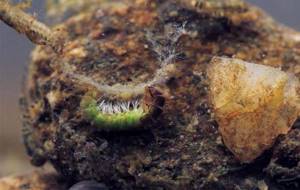
How to get caddis flies easily and quickly
Or rather, there will be more options, since it has been tested empirically by our fathers and grandfathers.
How to find caddisfly larvae in summer
In summer, such a butterfly larva will not be difficult to find. I went down to the water and immediately found it.
It is impossible not to notice the caddisfly - it is immediately visible among various bottom debris.
When you see some kind of stick crawling along the bottom and moving - this is “Shitik”.
The caddisfly lives near vegetation, so it is not difficult to find it among the grass in the water. And also on stones and snags, branches.
Just be careful when you take the larva out of its house. Shitik is very gentle (it’s not for nothing that fish love it).
In order not to tear it, you need to carefully and one by one pinch off all the layers of its tiny house.
Source: zen.yandex.ru
Habitat
The movement of these insects into the grass occurs in the middle of summer. The water is better heated by the sun in the shallow water area and there is a greater amount of available food there. A caddisfly larva will appear on almost every tuft of grass pulled onto land. The plants are full of this type of bait. The house of the caddisfly larva looks like a cover. The insect uses silk as a binding material, which it secretes. This process uses blades of grass, fallen leaves, debris, sticks, sand, shell fragments and small pebbles. The insect stays firmly in its home, so it is difficult to get it out without damaging it. The caddisfly, whose larva serves as an excellent bait, is eaten by the fish along with the case. The “dressed” version is more familiar to underwater inhabitants, so cleaned specimens, which are much tastier, cause an instant stir. In this case, the caddisfly larva brings a larger catch, and in use it is more effective than maggots or worms. Perch, roach, pike, bream and other species are caught this way.

Varieties
The caddisfly and its larvae have several species. Their descriptions and lifestyles are somewhat different. So, some individuals live at the bottom, while others float to the water surface (the houses are made of light material - grass containing air). Their food is algae pulp. This is responsible for the large number of insects in plants.
There are predatory species of caddis flies. They do not weave a cover and are very mobile. Using a thin thread, insects cling to stones and shells at the bottom, resist the current, and create a network of cobwebs that looks like a funnel. The food source is mosquito larvae, small crustaceans and mayflies. Such a larva has a strong jaw - this helps to quickly cope with prey. Such individuals are of little interest to fishermen, since finding and storing them is difficult. Preferable are shitiki - larvae living in the house. They are assembled by hand. There are a large number of them in the grass in summer. For this purpose, plants are examined very carefully - it is not immediately easy to notice the camouflage of the larvae.
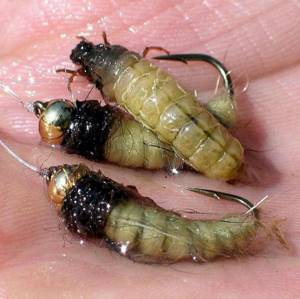
What is a caddisfly?
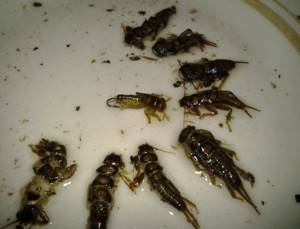
By its nature, a caddisfly is a larva of a meadow butterfly that lives in a built “house”, or cover. When the period of transformation begins, the caddis fly gets out of the water and prepares for the transition to a new life. Only in appearance the shitik is quite trivial and unattractive.
What does a caddis fly look like?
To many, it may seem completely disgusting, since it has a segmented body, three pairs of spiny legs and powerful jaws. Moreover, this entire set is reddish-transparent, reminiscent of the color of a cockroach or other parasites.
What does a caddis fly eat?
The caddisfly is a typical predator. Its diet includes mosquito larvae, mayflies, and even small crustaceans.
Production
The larva is easily removed, especially if the fisherman has experience in this matter. In case of danger, the caddis fly is completely immersed in the shell. The posterior tip of the tube contracts. On the other side, a head pokes out. They carefully take it and pull it to remove the whole body. The insect has jaws and does not look the most pleasant, but this should not be an obstacle. A fisherman who knows his business acts confidently and without hesitation. You can be absolutely sure: a caddisfly is not able to bite through a finger. The bait is taken out of the shelter by pressing on the walls - the larva remains intact. The naiad (dragonfly larva) is obtained in the same way.
Caddis flies are used as bait in all seasons. The methods of extraction in winter differ from those in summer. They are more complex, as are the procurement methods. However, if you want, everything is possible. This tradition comes from Karelia, where special preliminary measures for breeding bait were traditionally welcomed. For example, before freeze-up, a place was chosen on a river or stream, and the bottom was covered with bath brooms and stones holding them down. Before fishing began, the brooms were taken out, and when the fisherman began to shake them, larvae fell onto the ice. By the next time, new insects had stuck to the products. The broom became a shelter and refuge for the caddisfly, especially when the object was sprinkled with flour or something edible (lard, bread) was attached.
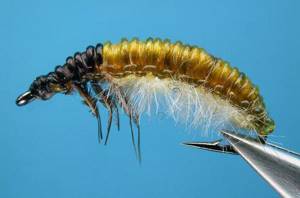
Bait storage
Serious and experienced fishermen know how to preserve caddisfly larvae. To do this, use a damp cloth, a plastic box, and also use strips of wet foam rubber. Outside the house, individuals quickly die. Long-term storage is possible when the bait is laid out in a row and tightly wrapped so that the insect does not leave the home.
If the temperature is cool, the caddisfly will live for another month. To make the larva mobile before fishing, use a cloth bag placed in water. The assembled houses on polyethylene are laid in one layer at a short distance from each other, otherwise damage may occur during thawing. Place a second layer on top and place in the freezer.
Acting carefully and scrupulously, fishermen provide themselves with bait for their next fishing trip: they cut off the required amount with scissors, and put the rest in a box. On the way to the reservoir, thawing occurs, so subsequently it is easily mounted on the tip of the hook. The larva is first freed from the house, if this can be done. Otherwise, the cover is broken or the back of the insect is pierced with a pin.
How to store
The larvae are usually kept in a wet rag in a plastic box with several holes. Some fishermen use wet foam, which is used for packing household appliances. The caddisfly turns out to be an incredibly tenacious insect if you do not deprive it of its home.
To preserve caddisflies for fishing in winter, use ordinary plastic bags with clips. The caddis flies are laid out in a row so that the larvae do not touch each other, packed in bags and sent to the refrigerator. You can also store it in the freezer, but these will no longer be living larvae, which need to be thawed before use.
Usage
During fishing, the larva is placed on a hook and a float is used. In conditions of strong current, the bite is good: the float deviates to the side or quickly goes down and the wait lasts for several moments. The fish swallows the caddisfly, and then the hook is made and the fishing line is quickly reeled in.
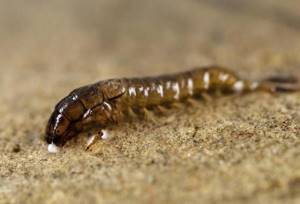
The target, meanwhile, tries to swim away into the thickets. To prevent it from falling off, the rod is held perpendicular to the bank, directing the prey to the center of the river. The current adds to the force of the escaping fish, which causes difficulties. However, by acting decisively, fishermen get a solid catch.
Having tried to use this bait, people are convinced of its effectiveness compared to worms and maggots, so they use it constantly.
